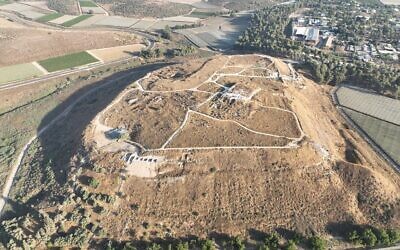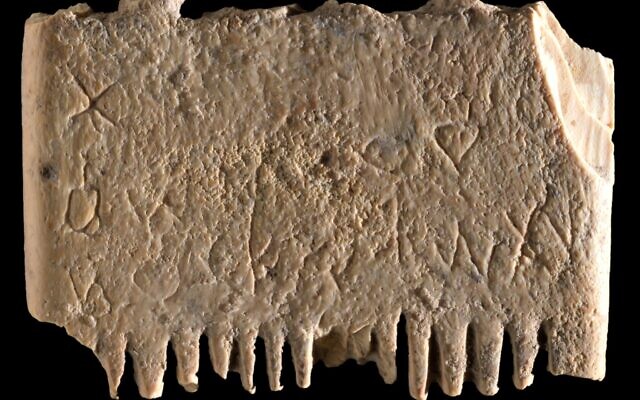4,000-year-old Canaanite hair care advice discovered on lice comb in Israel
The comb's inscription, "May this tusk root out the lice of the hair and the beard", is direct evidence for the use of the alphabet in daily activities back in 1,700 BC.
The earliest discovered sentence in the ancient language of Canaanite has been uncovered in Israel on an ivory comb used to remove lice and eggs – dating back to 1700 BC.
The sentence includes a spell against lice, with the seven words reading “May this tusk root out the lice of the hair and the beard.”
The ivory comb was discovered in Tel Lachish in Israel, which used to be a major Canaanite city state in the second millennium BCE. It was also the second most important city in the Biblical Kingdom of Judah.
It’s not the first time ancient Canaanite inscriptions have been found in Lachish. In fact, 10 discoveries have been made to date.
According to Hebrew University, who participated in the discovery, Lachish used to be a major centre for the use and preservation of the alphabet during some 600 years, from 1,800-1,150 BCE.

Professor Yosef Garfinkel, who was part of the team, said it’s the first time a sentence in the Canaanite language has been found in Israel. Other inscriptions discovered in Israel usually only contain up to two or three words.
“There are Canaanites in Ugarit in Syria, but they write in a different script, not the alphabet that is used till today. The Canaanite cities are mentioned in Egyptian documents, the Amarna letters that were written in Akkadian, and in the Hebrew Bible,” Garfinkel said.
“The comb inscription is direct evidence for the use of the alphabet in daily activities some 3700 years ago. This is a landmark in the history of the human ability to write,” he added.
A closer look at the comb, which originate from an elephant tusk, reveal that the side of the comb with six thick teeth was used to untangle knots
in the hair. The other side, with 14 fine teeth, was used to remove lice and their eggs, similar to the ones found in today’s stores.
The discovery was made by a team from the Hebrew University of Jerusalem and Southern Adventist University in the U.S. under the direction of Professors Yosef Garfinkel, Michael Hasel and Martin Klingbeil. The inscription was deciphered by semitic epigraphist Dr. Daniel Vainstub at Ben Gurion University.
The ivory was tested by HU Prof. Rivka Rabinovich and BGU Prof. Yuval Goren. Their findings were published in Jerusalem Journal of Archaeology.

Thank you for helping to make Jewish News the leading source of news and opinion for the UK Jewish community. Today we're asking for your invaluable help to continue putting our community first in everything we do.
For as little as £5 a month you can help sustain the vital work we do in celebrating and standing up for Jewish life in Britain.
Jewish News holds our community together and keeps us connected. Like a synagogue, it’s where people turn to feel part of something bigger. It also proudly shows the rest of Britain the vibrancy and rich culture of modern Jewish life.
You can make a quick and easy one-off or monthly contribution of £5, £10, £20 or any other sum you’re comfortable with.
100% of your donation will help us continue celebrating our community, in all its dynamic diversity...
Engaging
Being a community platform means so much more than producing a newspaper and website. One of our proudest roles is media partnering with our invaluable charities to amplify the outstanding work they do to help us all.
Celebrating
There’s no shortage of oys in the world but Jewish News takes every opportunity to celebrate the joys too, through projects like Night of Heroes, 40 Under 40 and other compelling countdowns that make the community kvell with pride.
Pioneering
In the first collaboration between media outlets from different faiths, Jewish News worked with British Muslim TV and Church Times to produce a list of young activists leading the way on interfaith understanding.
Campaigning
Royal Mail issued a stamp honouring Holocaust hero Sir Nicholas Winton after a Jewish News campaign attracted more than 100,000 backers. Jewish Newsalso produces special editions of the paper highlighting pressing issues including mental health and Holocaust remembrance.
Easy access
In an age when news is readily accessible, Jewish News provides high-quality content free online and offline, removing any financial barriers to connecting people.
Voice of our community to wider society
The Jewish News team regularly appears on TV, radio and on the pages of the national press to comment on stories about the Jewish community. Easy access to the paper on the streets of London also means Jewish News provides an invaluable window into the community for the country at large.
We hope you agree all this is worth preserving.






















